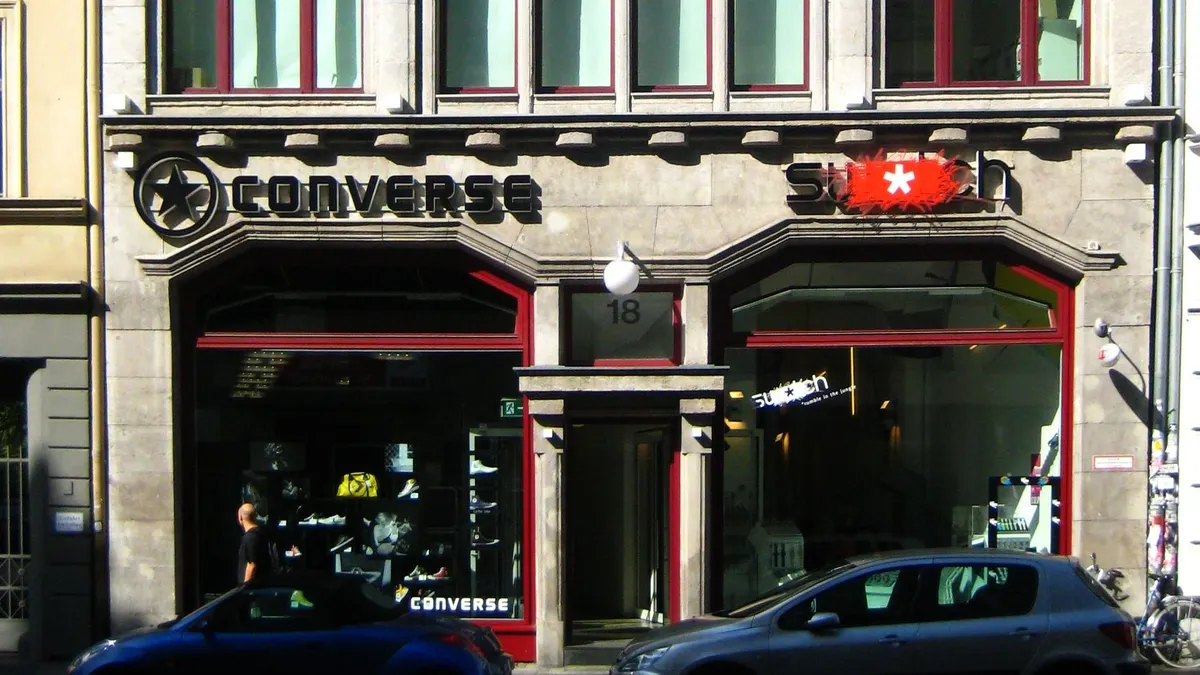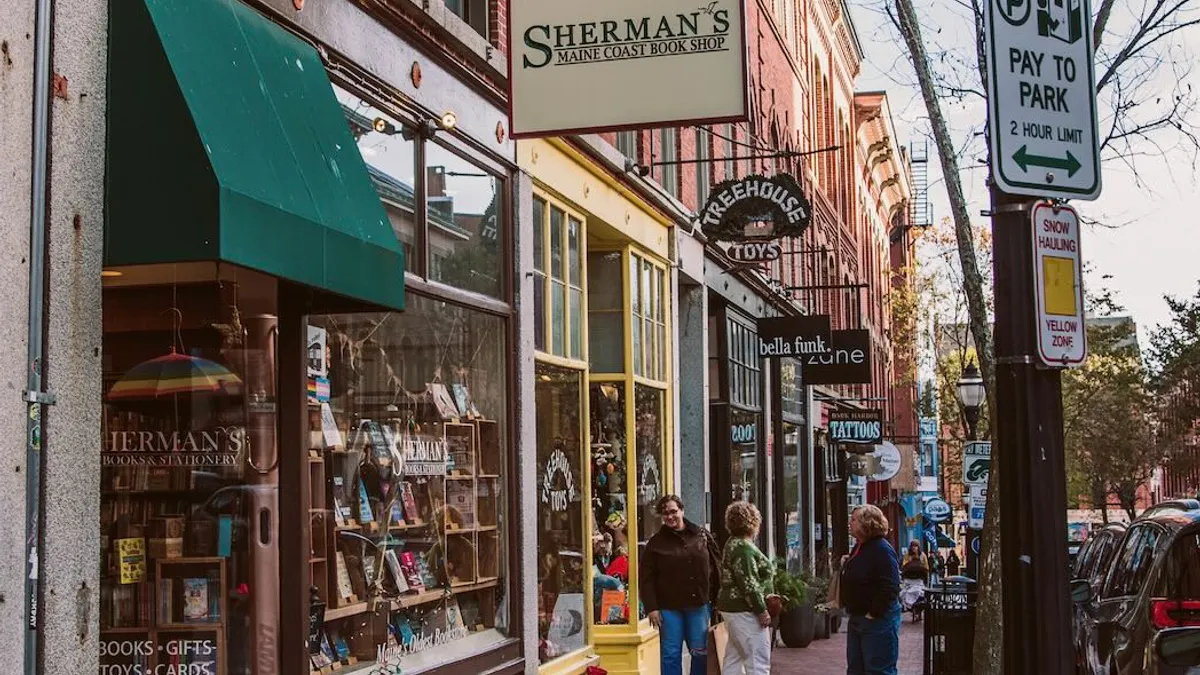Over the holidays, a time of consumer spending strength that lifted most, a few unlucky retailers — including Tiffany & Co., Macy's and Nordstrom — suffered disappointing numbers. J.C. Penney was also in that sad group, as its holiday comps tumbled 3.5% (5.4% without a sales timing shift), but it's facing an even more alarming truth — that its seasonal weakness may be less of a disappointment only because it wasn't much of a surprise.
It's been a long haul for the 110-year-old discount department store, which just recently welcomed yet another new chief executive, former Joann chief Jill Soltau, after Marvin Ellison left last summer to take over at Lowe's. Soltau, already under pressure to speed up an ongoing turnaround, faces the need to take extreme steps, with very little room to maneuver. In fact, a picture emerges, in speaking to several analysts, of a company handicapped by a series of contradictions, squeezed at many points by rocks and hard places. It has too many stores, yet not enough real estate to sell to be very lucrative. It holds $4.2 billion in long-term debt and has other liabilities, yet can't easily cut expenses or financially engineer its way back to life. It has new leadership, yet key positions remain empty.
"It's not an encouraging sign when a retailer hires a 'Chief Transformation Officer' before it fills its Chief Merchant and its CFO positions," Erik Gordon, a professor at the Ross School of Business at the University of Michigan, told Retail Dive in an email regarding Soltau's emerging team. "You sell merchandise, not transformation, and when the market has questions about your finances, getting a CFO whom the market trusts is more critical than announcing that you have brought on a transformation person."
Above all, though, Penney must hasten its turnaround, yet a recovery will take time.
"The holiday season results for the company didn't come as a surprise to the market," Ray Hartjen, marketing director of RetailNext, told Retail Dive in an email. "JC Penney has been in a slow death spiral for a number of years, and the company has turned into a case study illustrating that not making tough strategic decisions in the C-suite is, in fact, making a decision. Soltau has to move fast now, and she's handicapped with a vacuum in strategic leadership."
The hangover
This isn't the first time that Penney required a drastic overhaul. That was the mandate given to Apple store guru Ron Johnson when he was hired to take over as CEO in 2011, but just two years later he was given the boot. His interpretation of "drastic" was deemed too drastic, and even he, and those who defend him, now admit that it was executed too quickly.
All that appears to have given Penney an allergy to necessary change, according to Doug Stephens, founder of Retail Prophet and author of "Reengineering Retail: The Future of Selling in a Post-Digital World," who upon Johnson's appointment predicted that the company wouldn't have the stomach for his moves. The nauseous retailer promptly brought back former chief Mike Ullman out of retirement.
"Mike Ullman blazed a trail into the past," Stephens told Retail Dive in an email. "When Marvin Ellison took over, he focussed on stopping the bleeding and never made the kind of wholesale change that was required. In fact, it was shared with me by a very senior executive at JCPenney that even the word 'innovation' was practically prohibited within the company walls, given the disruption in Johnson's wake."
The question of whether Johnson was right or wrong will likely never die, but the retailer has to leave that for others to answer, and regain the courage it demonstrated when it hired him, according to Stephens.
"If they were going to seriously attempt a resurrection, it would require that they blow up their entire business model and go-to-market strategy," he said. "They would have to be willing to lose many of their older customers in the short-term in order to win new customers over the long haul. They'd have to completely throw out their real estate strategy given that they're in some of the worst real estate in the country. They'd have to rethink their stores from the standpoint of making them fun, entertaining and enchanting places that people (especially younger people) can enjoy spending time. They'd have to reclaim space from products to stage incredibly unique experiences and events. Essentially, they'd have to take the business back to the studs and work from there."
But not Johnson style, in one fell swoop. Stephens said the company should focus on getting a new strategy right in one store before trying to push any changes across its full store fleet.
That was the tack taken by Soltau when she engineered a turnaround at Joann, a sewing and crafts chain that was crying out for a marketing update. It's doubtful, however, that she's ever encountered anything like the task before her at J.C. Penney.
Retrenchment
When it announced its holiday sales, J.C. Penney also said that it will shutter three more stores (after closing more than 140 two years ago) and continue to evaluate its footprint, about 870 locations in the U.S. and Puerto Rico. But every analyst Retail Dive interviewed for this article said that the company must again be prepared to shutter a good portion of its fleet.
One basic reason for that is familiar: The company, like Macy's and Sears, is operating within a department store model that today's shopper has little use for, according to Allen Adamson, a professor at New York University's Stern School of Business and co-author of "Shift Ahead: How the Best Companies Stay Relevant in a Fast-Changing World."
"This concept was created when one-stop shopping was important — you had to get in your car and it was just easier," he told Retail Dive in an interview. "Consumers' desire to get everything all in one place just isn't as strong anymore. If they want makeup or mattresses or appliances they go to [a specialty retailer] or they go online. By definition the challenge they face is that most of these stores, be it Kmart, Macy's, Sears, J.C. Penney and to some extent even Target, if they're in all these categories, they're not going to be best in any of those categories. And if they're only average at everything — they don't win at anything."
The result is a J.C. Penney that can't compete on the things that matter to consumers: price, product and experience, he said.
That means, at the very least, shrinking, and RetailNext's Hartjen emphasized that time is of the essence. "The organization has too many stores, and most every store is too big in footprint for its business going forward," he said. "Soltau has to start now. A few store closings are just initial bumps in the overall ride. I'd look for her to aggressively reposition the brand around new product assortments and cater to a younger shopper generation."
The upshot of such a process, however, could mean "maybe as little as a quarter of the chain" survives, according to retail analyst Nick Egelanian, president of retail development consultants SiteWorks. "You might have to close half the chain just to get in the game."
It's a sort of real estate triage, saving only the best performing stores in the best malls. "It's finding which stores that, no matter what, I have no chance. Stores that you just shouldn't be putting resources into. Stores that can't stay because the mall is going to fail even if I got my store to work," Egelanian said. "It's not just the stores — it's the real estate they're in. Penney is in lots of better malls ... these are malls that are going to survive. Then, it better be relevant to the customer who's going to be shopping that mall 10 years from now or you have no chance. That calls for a complete reinvention."
Figuring it out
As difficult as it may be, the task of sorting out the best stores may be the easy part. Much harder is Penney's need to redefine itself for today's shopper, a consumer with high expectations who has a whole lot of ways to find more appealing goods more cheaply, more conveniently and in a nicer environment than what Penney offers.
"They need to figure out what JCP can be famous for," Eddie Yoon, founder of Eddie Would Grow, a think tank and growth strategy advisory firm told Retail Dive in an email. "Their current mission to 'help our customer find what she loves for less time, money and effort' is amazingly generic and ho hum. It sounds like what Amazon does, only exponentially better, cheaper and more convenient than JCP."
Penney does enjoy loyalty, and its reinvention should start there, according to Yoon. "Given the negative trends, the JCP superconsumer is likely much more important now. They need to assess what their share of wallet is with their best customers, which I'm sure is much lower than they realize, and ensure they grow that first and foremost. These superconsumers should be the heart of all their innovation for now."
That means cutting loose some of their base, though, others say. "The company desires the elusive riches from catering to a younger shopping generation," Hartjen said. "But, quite frankly, its core customer is that younger shopper's mother. Related to shoppers, both the desired target shopper and the core customer, there's a product disconnect, especially in apparel. And, finally, there's a clunky omnichannel infrastructure."
So it also means reassessing its assortment. The company has flailed in apparel, even after a dramatic reset over a year ago, and that can't continue, according to GlobalData Retail Managing Director Neil Saunders, who says that the category remains Penney's biggest problem and "is now having a negative knock-on effect on other sectors like home and electronics."
"The holiday period illustrated the depth of the challenges that JCP faces. The inventory position looks dire and just clearing this will take an enormous effort," he told Retail Dive in an email. "On top of this, customer numbers fell which suggests that the chain is falling off the radar of even once loyal shoppers."
The last chance
J.C. Penney declined to comment for this story, saying it wasn't ready to share details about its plans. Whatever they are, they'll likely reflect the retailer's last and only chance. Many experts have offered their guidance despite a belief that there's actually little to nothing to be done at this point.
"Don't bet your nest egg on a turnaround," Stephens said. "In all likelihood that ship sailed long ago."
Others aren't quite so pessimistic, however. The vast room for improvement also holds promise, according to supply chain expert Martin McDermott who teaches at the Purdue Global University School of Business. He joins others in saying that stores must shutter and e-commerce improve, and he too says it would be a lengthy process. But he also notes many in the industry believe that Soltau, (who in addition to her leadership of Joann soaked up a depth of retail experience at now-bankrupt Midwest chain Shopko), has the retail chops for it.
"The marketing environment has presented JC Penney with an opportunity to survive and maybe even thrive in the future," he told Retail Dive in an email. "The recent closings of several big retailers like Bon-Ton have provided JC Penney with an opportunity to increase their market share. ... [T]hey need to remove their slow-moving inventory and focus more on products that have been successful like their big and tall line. One of the weaknesses of JC Penney is they have an over assortment of products and are heavy on inventory. Accomplishing this task will allow JC Penney to focus on core strengths like customer service."
The scope of Soltau's task, however, is imposing and puts a great deal of pressure on her to get things right. Hartjen noted, "She'll need to appeal to [customers'] needs for product and for experiences, and she'll need to entice their loyalty through value. What's good for Penney's shopper is good for its business. There's just no time. She has to run, not walk, and she doesn't have the luxury of taking even a single misstep."
It's a race against time and a test of patience, according to Saunders. "There is now a very limited window in which to enact changes and improve sales. Ultimately, that means there is no room for error — whatever strategy Jill Soltau embarks upon has to be the right one. One false move could put JCP in very serious financial difficulty," he said. "Even with the perfect strategy, JCP is not going to be revived overnight. There is a great deal to fix and it will take time for any changes to filter through to customer perceptions and behavior."



















